Hard, Wonderful Life
By Mel Allen for Bowdoin MagazineNot so many years ago, Amy McDougal Burchstead ’98 and her husband, Jeff, created a thriving community supported agriculture farm in midcoast Maine.
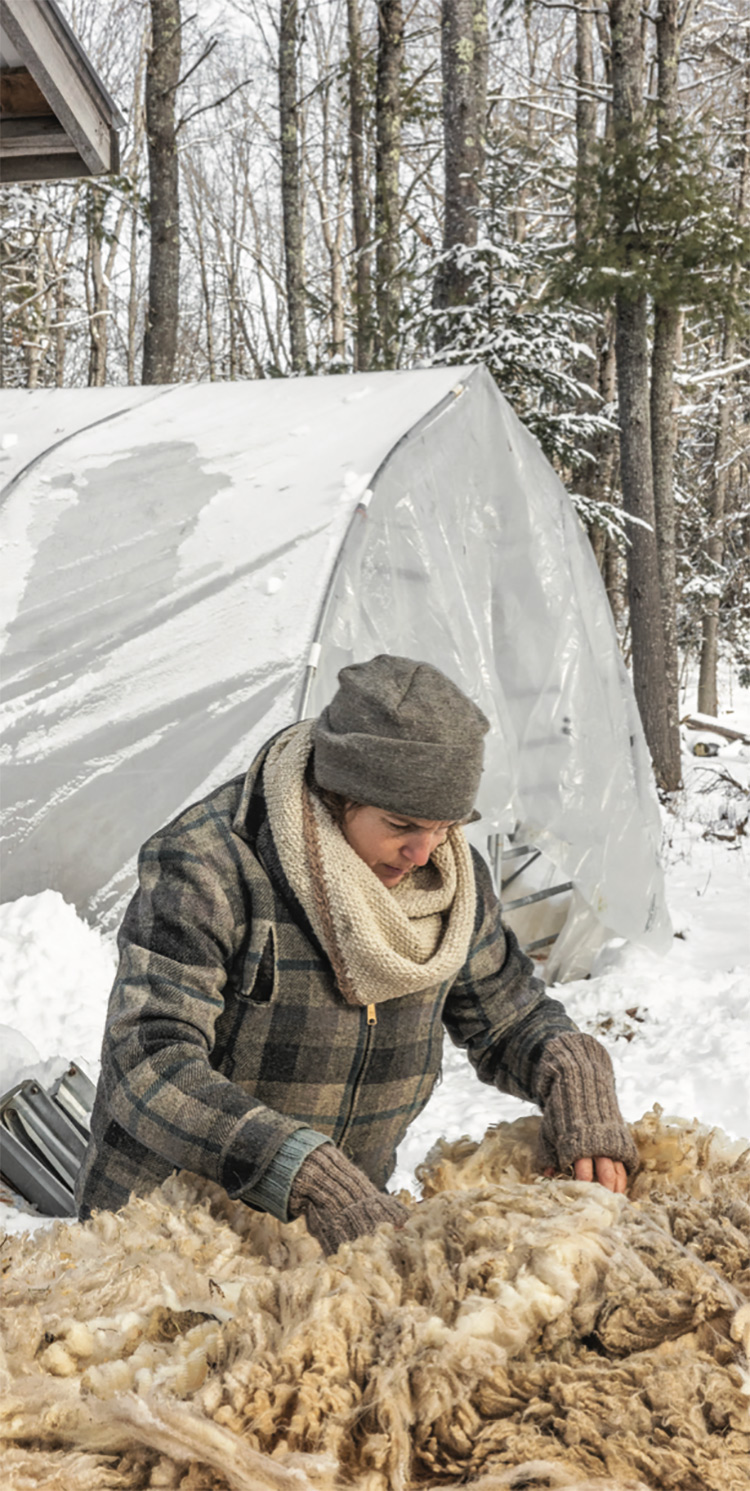
Using only draft horsepower, their Buckwheat Blossom Farm raised animals and produce on two leased tracts of farmland in Wiscasset while they slowly built their own homestead on 140 acres of forest that had not seen a family since the nineteenth century.
At one time they counted 300 laying hens, 600 meat birds, and fifteen pigs, along with beef cows, sheep, lambs, and turkeys. They had a waiting list of apprentices who wanted to learn from them. With six acres of cultivated vegetables along with meat and woolen goods, they served a winter CSA, a summer CSA, and farmers markets in Portland and Brunswick. “We wanted people to eat from our farm,” Amy says today. “We just felt it was special.” She describes how beautiful the bounty looked when laid out like colorful still life paintings as she met customers who came from miles around to buy pasture-raised meat and produce from ground untouched by chemicals and tilled with not a machine in sight.
That was a decade in the past. On this early blue sky morning, one of the final ones of 2022, I turn onto Hidden Pasture Lane, not far from Wiscasset center. At the end of the narrow dirt road, bordered by forest and patches of open ground with sheep looking on from the other side of fencing, is the timber frame farmhouse built in 2009 by Amy’s Bowdoin classmate Ravo Vihman. Amy, Jeff, their three children, and Amy’s sister, Anna, live here, about a quarter mile from Amy’s mother and stepfather, whose own home was built on this land they bought together in 2002.
Now, depending on the season, there will likely only be some twenty goats, two dozen sheep, egg-laying chickens. They still sell chicken and lamb, sheepskins, wool products, and apples at the Brunswick farmers market and wool goods, sheepskins, and goats from their website, but their children have grown up without people coming to their farm, and only their own family gardens to fill a root cellar, canning jars, and a freezer. In a time when many of us measure success with more and bigger and richer, and whether our social media followers have grown, I wanted to meet this farm couple whose value and meaning in their lives emerges, I will find, from a different sort of harvest.
When I walk in, the family is clustered by a wood cookstove. Amy is cooking a vegetable omelet, their border collie, Kit, and Mabel, a Chihuahua mix, stand by. Leah, thirteen, and Asa, ten, are homeschooled, while Ruth, seventeen, studies in an online curriculum, but this is school break. Asa is sitting on stairs, ball cap turned backwards. Ruth and Leah lounge on a sofa. Anna has already been picked up for her day at Spindleworks, the Brunswick art center for adults with disabilities. It is where Amy volunteered while at Bowdoin. “I missed my sister,” she says, whom she watched over while they grew up in New Hampshire. Anna tells people she has “Up Syndrome” and takes pleasure in selling her artwork at exhibits, as she thrives within the security of her big sister’s household. Socks hang on a line over the wood stove, drying. Sheepskins are draped over chairs.
Jeff walks in with an armload of wood. He brings worrying news. He found a ewe yesterday stumbling around, and when he looked this morning, she struggled to stand in her pen. He fears a parasite carried by deer that damages the spinal cord. They have worked with animals for nearly twenty-five years, and for the most part doctor their flocks themselves.
Amy and Jeff look at each other, saying little. They have seen life and death play out as natu- rally as the seasons change. One winter day they found a newly born lamb in a pasture, gray and still from hypothermia. For three hours Amy immersed it in a warm tub, trickling honey on its gums, massaging it until life returned. “You can’t ever forget a life coming back in your hands,” she says. They will keep checking on the ewe.
They say that every day there is more to do than there are hours. They say,“The good stuff is part of the hard stuff.”
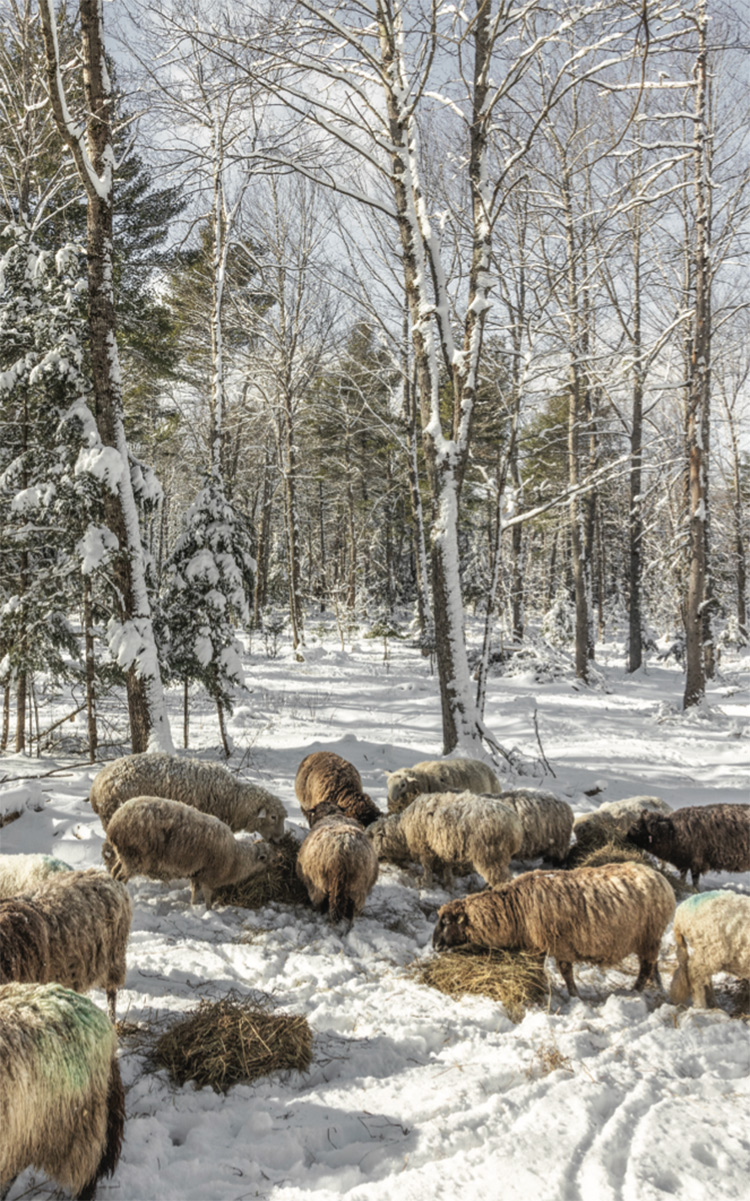
There is work to be done. Ruth will go for her daily run, Leah to her reading, Asa to wherever his father will go, especially if it involves a chance to drive the truck, which he has been doing since he was eight. There are horses to feed, wood to clear, hay to carry to sheep in the clearings among the trees, goats to milk in the hoop house, chickens to feed, sheepskins to dry, and—now that breakfast is over—a chicken and potatoes lunch to think about. They say that every day there is more to do than there are hours. They say, “The good stuff is part of the hard stuff.” Everyone goes to where they need to be, retracing steps taken day after day after day.
When Amy and Jeff tell their origin story, it becomes evident there was no way for them to be in this world without the other. For Amy it begins at Bowdoin, a junior year abroad. The yearlong study was called “Global Ecology,” part of an international honors program. A lifelong vegetarian, she had always cared about the environment, but living with families in England, Turkey, India, Thailand, and Mexico, seeing how they tended gardens no matter their status, how they made beauty from the natural world, opened her to possibilities. “It struck me how in touch with life they were,” she says, “and where their food came from, and where their resources came from. And how out of touch most of us are with that. I came home wanting to learn about agriculture and how to teach others.” Her Bowdoin roommate Dana Pratt recalls Amy coming home and saying simply, “It’s all about the land.” Jo Horn, another former roommate, adds, “She came back as a person who had context and perspec- tive on what she wanted to do with her life.”
After graduation, she became the education coordinator at the Morris Farm Trust in Wiscasset, a working heritage farm that invites the public to learn about sustainability and growing healthy food. She met Jeff Burchstead at a biodynamic composting workshop in Rockport. They discovered they each had loved Little House on the Prairie. “I thought, I am going to marry this man,” Amy says. Amy’s friends knew this was a different relationship for her when the devoted vegetarian began eating meat from the 250-acre organic farm Jeff managed in Gouldsboro.
By 2000 Jeff had taught himself the rudiments of shearing sheep—a technical and physical skill that requires dexterity, stamina, and the kind of coolness it takes to wrap your body against a sheep’s while handling powerful and sharp metal shears. There were only a handful of professional shearers left in Maine, and he had seen an oppor- tunity. Amy went with him on one of his first jobs.
“We were in a poorly lit barn,” she remembers, “and I was holding a big chart of positions he needed to put the sheep in. I read to him what the chart said. [Afterward] we were driving over the bridge to Edgecomb, and it was a beautiful sunset. We were covered in sheep poop, blood, urine, lanolin. We both reeked of sheep but we were excited that Jeff was figuring this out. And Jeff looks at me and says, ‘Will you marry me?’”
“I just figured if she could do that with me, then she could do anything,” Jeff says.
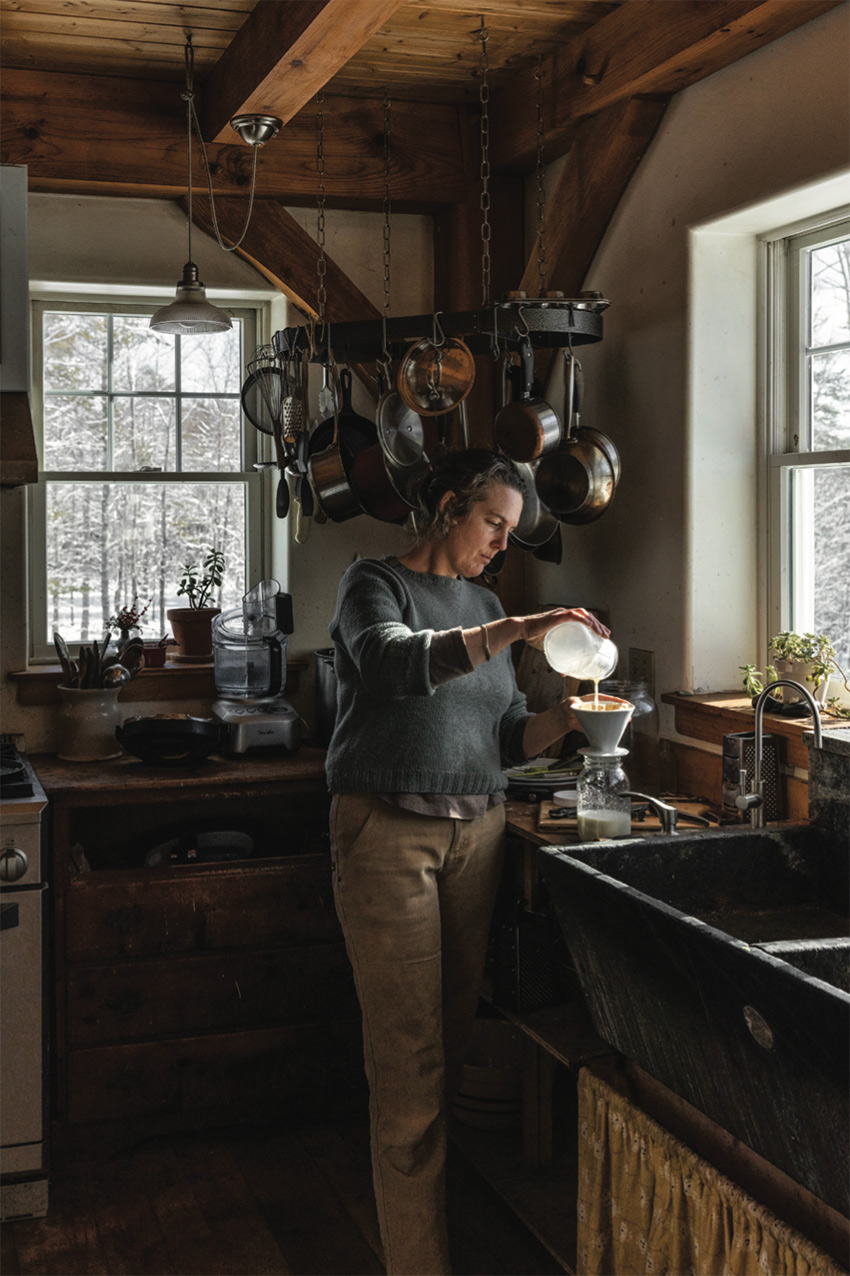
There may not be many Bowdoin graduates who began married life living in a yurt on uncleared land without running water or electricity, but Amy knew with a certainty that this is the life she wanted. What they lacked in amenities they made up for with an abundance of hope and a plan. They would carve farmland and build a home from the thick woods with the running brook that Jeff had found in 2002 while walking in the forest. When he showed the land to Amy, they agreed: This is the place.
Tree by tree, they cleared enough open space for a road and for a pasture for the animals. When Jeff is asked how he knew he and Amy could do this, he replies, “I knew it had been done before. We’ve never taken the easy way.” When Ruth was born in 2005, she was nursed in the yurt, Amy swinging diapers around to dry. She slept between her parents, a wool hat on her head. They moved with Anna to a nearby farm and, slowly, surely, a clearing emerged, a road was made, and their house was built. Leah came, then Asa, and, as Jeff’s shearing business kept him on the road through much of spring and summer, the stress of doing everything wore both of them down. Then, five years ago, Ruth suffered her first epileptic seizure, and Amy’s goals shifted. “I knew I would be there for her,” Amy says. “I would put some of my work on hold and get her through this.”
Amy would continue to grow her wool busi- ness, and Jeff would keep clearing land. They would stay true to their vision of agro-forestry, which provides shade and shelter to flocks while keeping soil alive and nourished, but Amy now would focus more than ever on the children and their passions. French lessons, music lessons, photography lessons, weekly library visits for books on wherever their curiosity led them, being on site when Ruth competed in Nordic skiing. She would raise children filled with competence, able to be deft with their hands, to work with wool, sew and patch, make wreaths, grow their own vegetables, explore a forest, birth and love animals while knowing their nourishment also came from them.
In the morning Amy and I go into a hoop house where sheep and goats and chickens stay warm and dry in the winter, with hay underfoot. It smells farmy and fur-warm, as chickens cluck and goats and sheep let Amy know it is time to eat. To Amy, sheep are perfect animals, providing wool, meat, and milk in return for pasture and safety. They connect her, she says, to what she calls “agricultural memory,” to sheep farmers through centuries. “The strands of history are unbroken,” she says. “We are part of it.”
She carries fir brush and branches and throws them into the pens for the goats. “The tree roots go deep into the soil,” she says, “bringing up minerals that they don’t get from surface grasses. And that goes into the milk.” Milking goats is one of her favorite daily tasks. “These are some of my favorite animals on earth, and I sit peacefully with them while I milk. Usually no one is asking me to do anything other than what I am doing, which is a treat.” Her mom or the friends she calls while she milks are used to hearing the sounds of milking on the other end of the line.
We go into their greenhouse, where a dozen sheepskins dry on a long table. She once wrote that a sadness crept in when creatures she had nurtured left the farm, but she knew she was feeding family and neighbors with healthy meat from animals who never knew confinement in factory farms. When the skins are dry, she will send them to a tannery she found that uses no chemicals.
Before noon the family gathers for lunch. Money can be scarce at times, but their life is full of bounty. The table is set with chicken, potatoes, carrots sweet enough to be dessert, sauerkraut, watermelon radishes, goat cheese, applesauce, and apples from Amy’s aunt’s orchard in Fairfield. They practice thrift. They wear sturdy clothes and when needed they patch and wear them some more. They barter when they can and know they can usually make something better than they can buy new. They make time for small delights, like Asa’s loose tooth that escapes at lunch with the crunch of an apple.
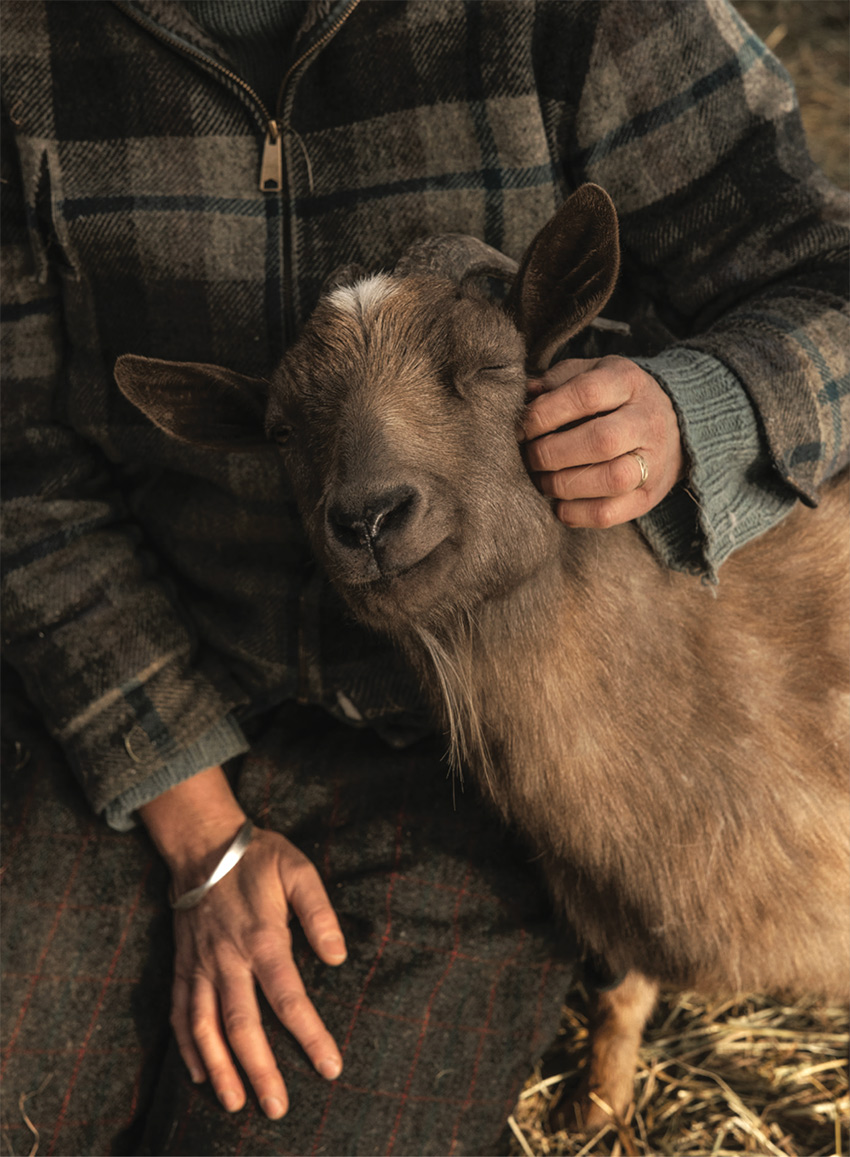
After the meal, the hours slide along into the afternoon. The warmth of the sun softens. Amy and Asa set up her skirting table in front of the wool shed. Inside, large black plastic bags pile atop one another, each filled with raw wool. Some from their own sheep, still more from farms where Jeff has sheared and the farmers are happy to give or sell the wool.
Amy hauls out one bag at a time and empties the wool onto the mesh table. Her fingers comb through a handful at a time, and because it needs to be clean for spinners, she discards “the yucky stuff,” the fibers with speckles of manure clinging like burrs. Nothing is wasted. Scraps on the ground will decompose into mulch. Her hands become greasy with lanolin, the oil that sheep produce to protect their skin and that makes their coats waterproof. The bags in the shed are many, the daylight too short. Rain is forecast, and Amy has to get as much done as she can before it arrives. She holds out a handful of clean wool and describes it the way a chef might speak of flavors.
“See, this wool here is good enough to go into socks. It’s soft and it’s got some spring to it. It’s not going to slide off. It’s got memory, elasticity.” Her fingers do not pause. The wool finds a home in a bag labeled “soft.” If she had not told me, I would not have known she was dealing with brain fog and tingling from tick-borne Bartonellosis, and that each day takes “a mountain of remedies.” This day is uncommonly warm, but when it gets cold, she wears mittens her mother made for her with holes for her fingertips. She gathers more wool. It is coarse, what she calls “britchy,” and she puts it in a bag that says “comforters.”
Many days she will skirt like this for hours. I ask where her mind goes while sifting. She smiles. The skirting table is like her studio, a chair in a quiet library. “In my house,” she says, “there isn’t a lot of space to just think. This is my time alone. Here is where I make plans, think about school or a challenge someone may be facing. I design houses in my head. I caught the bug when I designed our house. That’s what I do when I can’t sleep.”
She has brought along the award-winning Ox-Cart Man, a children’s book written by Donald Hall. It tells of an early-1800s farm family on a New Hampshire homestead. The farmer fills his oxcart with woolens, linens, apples, maple syrup, hand-wrought shingles, candles, brooms carved by his son, honey, and potatoes, everything from their land and hands, and he walks ten days to market, sells it all, including the cart, yoke, and ox, then walks home, and the family’s work begins anew.
“My business plan is to have the family working together, each doing our own thing that we’re passionate about.”
“When I think of my family’s business plan, it isn’t growing five acres of vegetables to make $30,000,” Amy says. “My business plan is to have the family working together, each doing our own thing that we’re passionate about. Having it be something people can really use. Going to town, selling it all, coming home, and doing it all over again. I just love that. I have such peace with that idea.”
Jeff and the horses clop by, stopping down the road. We hear wood being thrown onto the wagon. Ruth, Leah, and Asa are reading inside the house. In an hour Anna will return home from Spindleworks. I ask Amy about a typical day and she laughs lightly at the notion, as if there might ever be such a thing. If she made a list of what a day might hold—homeschooling, milking, feeding sheep and goats, making cheese, yogurt, and kefir from their milk, being with Anna, making farm plans with Jeff, preparing meals from scratch morning to night, packing orders for customers, scraping skins, skirting wool, washing yarn when it comes back from a mill— the list would seemingly not end. She tells about speaking at the New England Farm and Fiber Festival in Boston. She was on a panel of women sheep farmers. “I was asked what my biggest accomplishment was and what I was most proud of on our farm,” she says. “I said that every day felt like an accomplishment, a goal achieved. All the children and animals were in their place, fed and safe for the evening, all was quiet. And I had earned an hour or so to read and drink my tea.”
In a few days schooling begins. In two weeks, she and Ruth will spend a few days in a clinic monitoring Ruth’s sleep patterns to see if her now-quiet epilepsy might be affecting her sleep. Soon after, snow will settle on the farm, turning it into a wonderland, making Jeff and the horses happy as they pull logs along the trails. In the morning, Jeff and Asa and Anna will load the truck with coolers full of lamb and chicken and a basket of apples for the winter market in Brunswick, along with yarns, a rug Amy just finished crocheting, wool ready for hand-spinning and felting, comforters, and socks. Amy will stay home and catch up on things, knowing she will never catch up, and that that is part of the challenge and the joy.
“Most people when they drive up here, they’re like, ‘My God, it makes me tired. Just seeing everything you’ve done and everything you still have to do.’ It’s hard for people to understand,” Amy says, “but I like what I’m doing. I like the feeling of getting things done. I wake up each morning excited for my day.”
Mel Allen is editor of Yankee Magazine in Dublin, New Hampshire.
Greta Rybus is a freelance photojournalist based in Portland, Maine. Find her work at gretarybus.com.
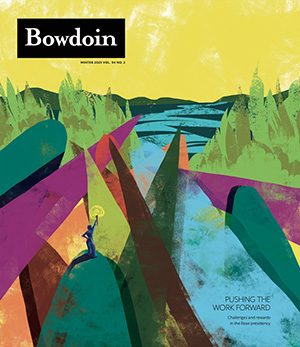
This story first appeared in the Winter 2023 issue of Bowdoin Magazine. Manage your subscription and see other stories from the magazine on the Bowdoin Magazine website.